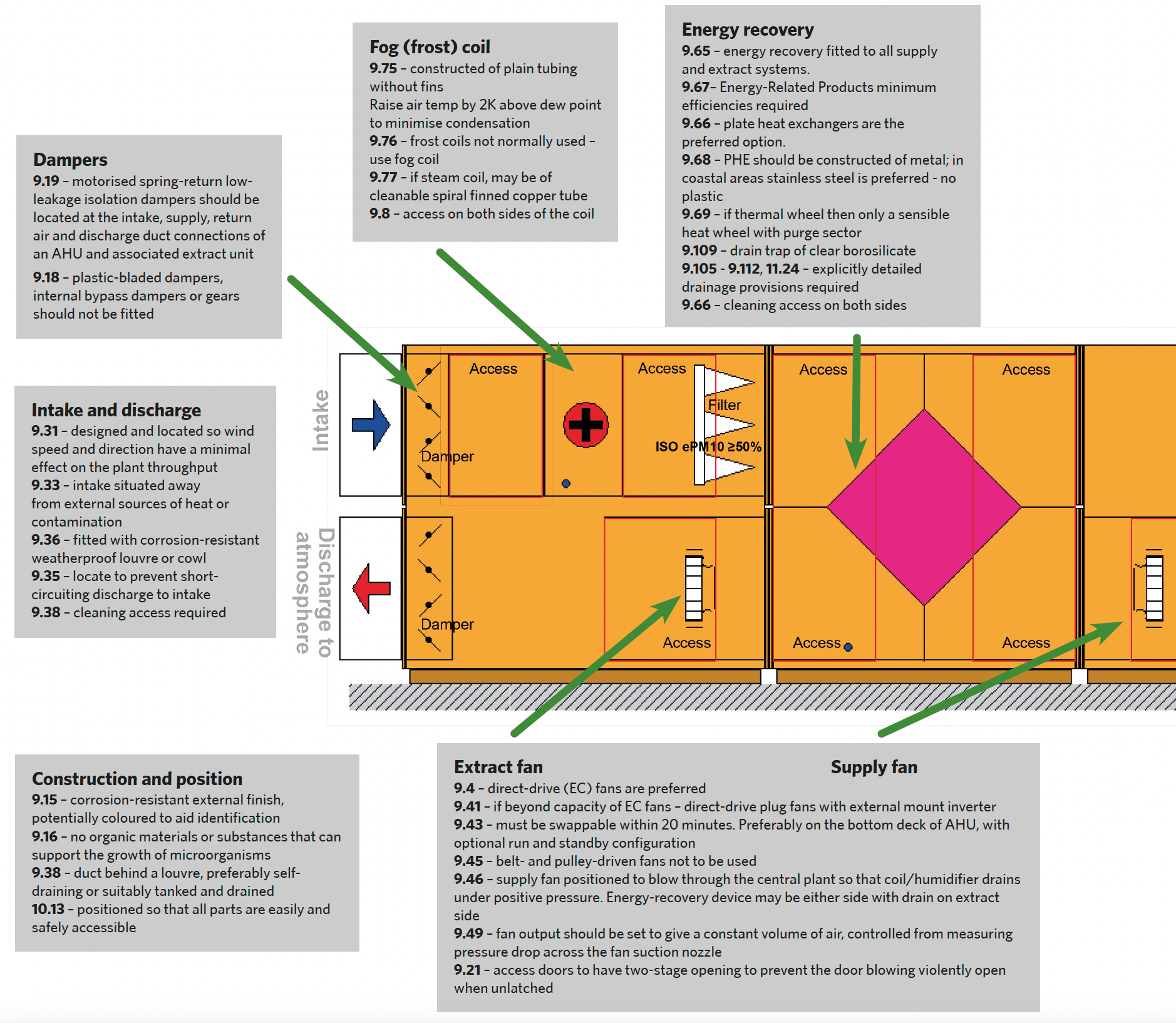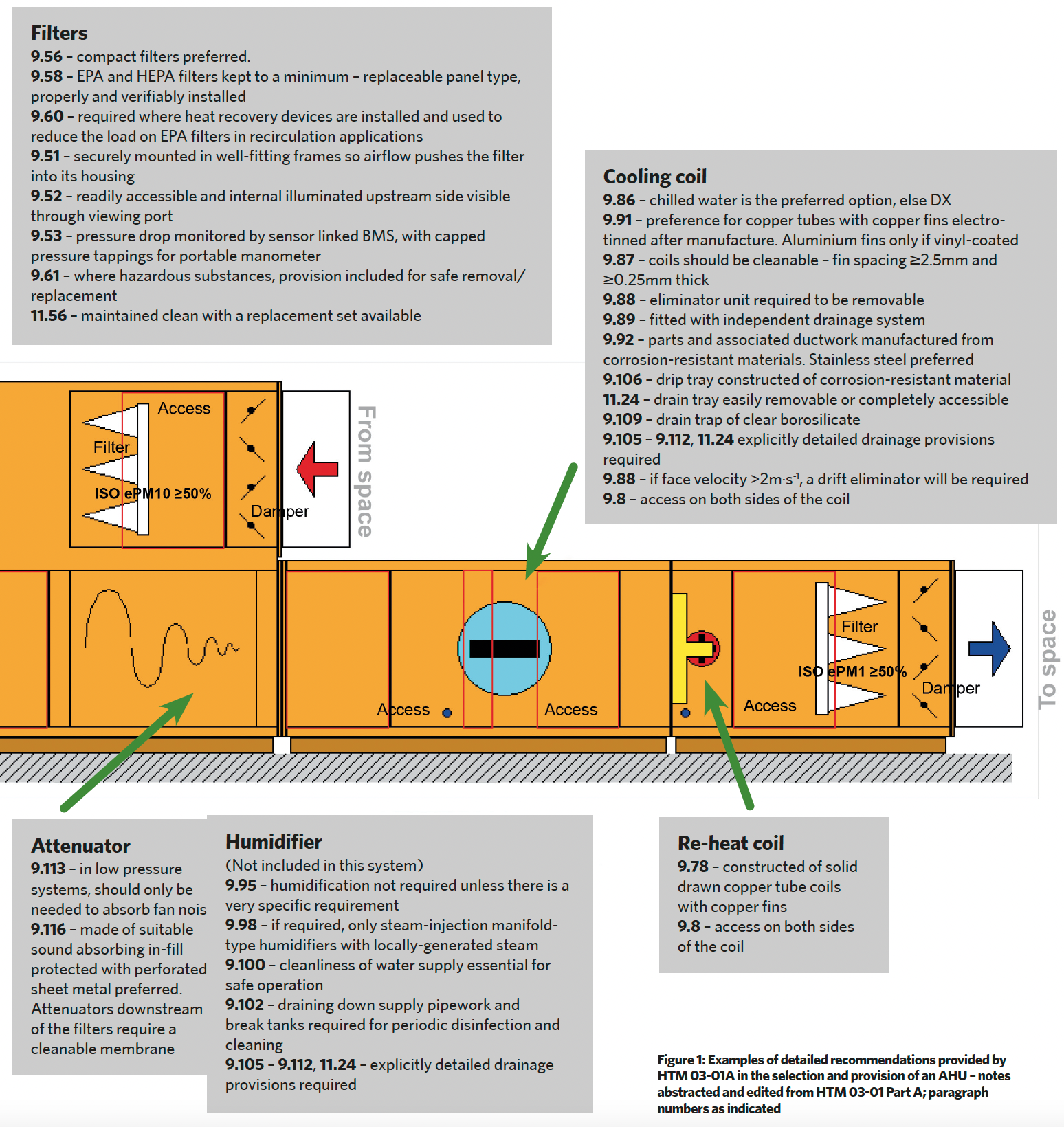For those who work in the design of technical services and installations for UK healthcare premises, the primary set of references are the Health Technical Memoranda (HTMs) (which exist in a parallel form for each four health systems of the UK nations). The freely downloadable HTMs provide an incredibly useful resource well beyond the confines of healthcare premises and make a useful adjunct to any building services engineering library. This article will provide an introduction to the HTMs and concentrate on information from one of the most recent updates, part A of HTM 03-01 Specialised ventilation for healthcare premises.
Emissions resulting from building energy use in the NHS dropped by almost 50% in the period 2013 to 2019, most significantly as a result of the decarbonisation of the UK electricity grid.1 However, robust design and operation present continuing opportunities to reduce systems energy use towards the goal of net zero by 2040.2
The potential for significant environmental and cost benefits of good quality, holistic design and operation of engineering systems is immense. The various HTMs are connected by HTM 00,3 which considers the policies and principles of healthcare engineering, providing the underpinning management and operational policies that have been drawn and developed from earlier documents, and also explores issues of risk management. The series of HTMs has evolved and transformed since the establishment of the NHS in 1948, and is now focussed on eight specialist areas.
HTM 03-01 Specialised ventilation in healthcare premises has two parts. Part A: The concept, design, specification, installation and acceptance testing of healthcare ventilation systems sets the standard for new installations and major refurbishments of existing installations. Part B: ‘The management, operation, maintenance and routine testing of existing healthcare ventilation systems sets the standard irrespective of the age of the installation.
This article will focus on the recently updated HTM 03-01-A that provides extensive guidance amounting to more than 200 pages, which is complemented by the 60 pages of HTM 03-01-B.
In many areas, the challenges for ventilation include appropriately reducing the bioburden and other contaminants in the air to protect the patient, other patients and personnel, both locally and beyond, as well as addressing the control of increased fire risks where there are more flammable materials and chemicals, or less able patients.
Practically all areas will require reasonable comfort conditions, even where widely diverse clothing is worn by occupants – patients and personnel – in the same space. The updated HTM includes revised design information for specific healthcare applications together with rationale given for any significant changes.
A substantial section of the HTM provides the requirements that relate to particular healthcare zones, such as operating departments and interventional imaging suites, as well as explaining the needs for more generic zonal functions such as ultra-clean ventilation systems, extract systems and plantroom ventilation.
A brief commentary on legislation for UK healthcare premises covers the Building Regulations, COSH, Health and Safety at Work Act, and Workplace Regulations, as well as those specific to healthcare such as the Health and Social Care Act, the Medicines Act, and Human Medicines Regulations.
Among other significant changes, notes on resilience and diversity permeate across the guidance.
Required standards of air quality have developed since the previous 2007 edition, now aligned with BS EN 16798-3:2017,4 and filter requirements now refer to ISO 16890.5 In tune with the zeitgeist, there is more specific coverage on refurbishments and change in the use of an existing installations, with specific information on life-cycle analysis and updating of mid-life plant.
The importance of appropriate handover information is highlighted as aiding this process, as well as informing the selection of replacement parts and equipment. All new major projects are required to use BIM to ensure coordinated design, provide information for the operational phase and possible future development. The ‘soft landings’6 approach is strongly recommended for the client and contractor.
The considerations that relate to the equipment selection and installation provide the largest section in HTM 03-01-A. These include extensive and detailed recommendations to ensure that the equipment is suitable for application in a healthcare setting, as well as ensuring the best life-cycle performance.
When discussing installation standards, the HTM frequently emphasises the need to include sufficient space, access and facilities to reach and handle all elements of the plant that would reasonably need maintenance or replacement. The newer technologies and increased versatility of control have enabled increased granularity in the specification of acceptable airflow rates for specific applications aimed at reducing energy consumption while maintaining air quality.
As an example of the depth of detail provided by the HTM, when selecting an AHU, criteria drawn from the various HTM sections would be applied as illustrated in the example notes of Figure 1.



Detailed information is given on the commissioning process, and standards and methodology for acceptance have been completely revised. All new and refurbished ventilation systems are required to be independently validated (not simply commissioned) to assess ‘fitness for purpose as a whole’ prior to acceptance by the client.
The validator, a suitably qualified competent engineer familiar with healthcare ventilation requirements, will be appointed and paid for by the client and be completely independent of all those involved in delivering and operating the installation. They will be involved throughout the complete project cycle and have extensive responsibilities, although the validator will not be responsible for snagging.
The HTM requires that the energy consumption of ventilation systems should be minimised by specifying solutions with the lowest life-cycle environmental cost, with the core objective of energy-saving strategies in the HTM aimed at providing the required ventilation service using minimum energy.
HTM 00 notes that whatever the solutions, they should be specified with the lowest life-cycle environmental cost. Routine inspection and maintenance guidance has been revised and updated, with pragmatic recommendations included.
The changes to HTM 03-01 made since the previous 2007 edition are significant and merit a thorough inspection of the revised document. However, the changes are not retrospective but look forward to the revised recommendations being carried through in new installations and major refurbishments.
The HTM provides a salutary warning that designs that are simply repeated from previous installations, designed to superceded standards and guidance will not meet the revised energy or operational standards – and will not produce a compliant result.
© Tim Dwyer, 2022.
